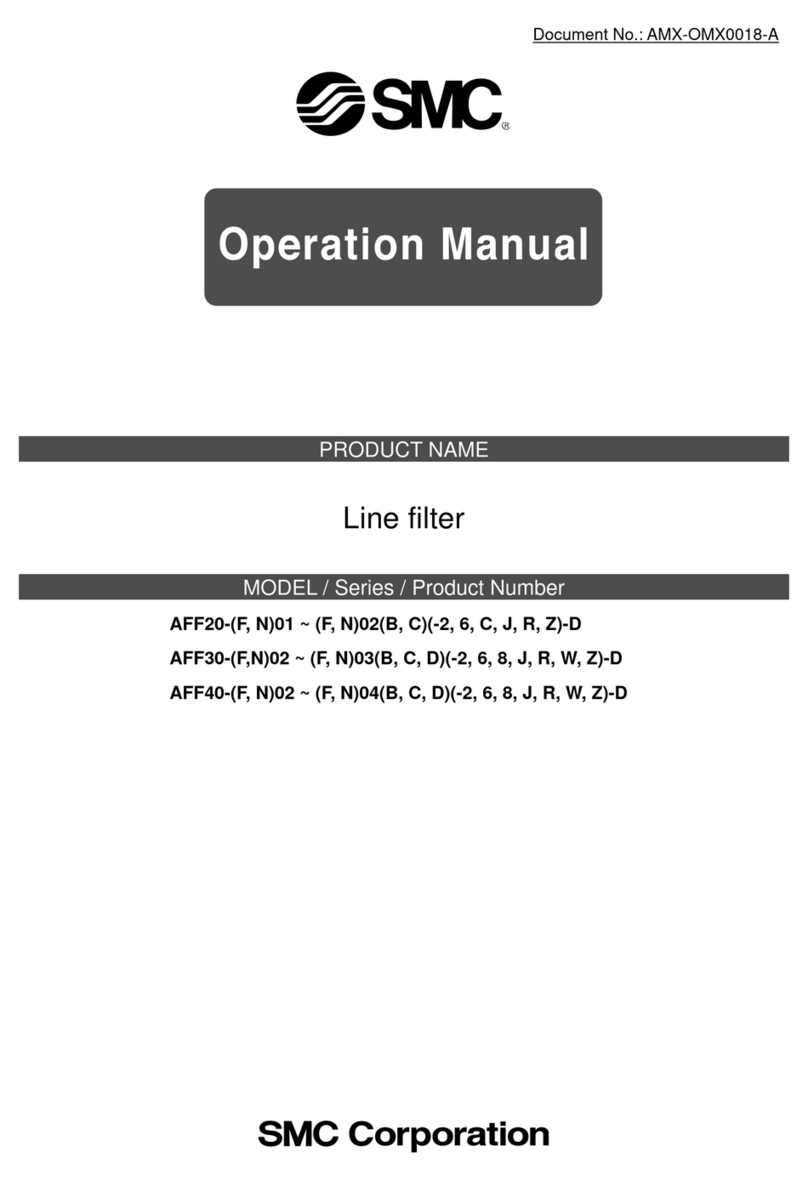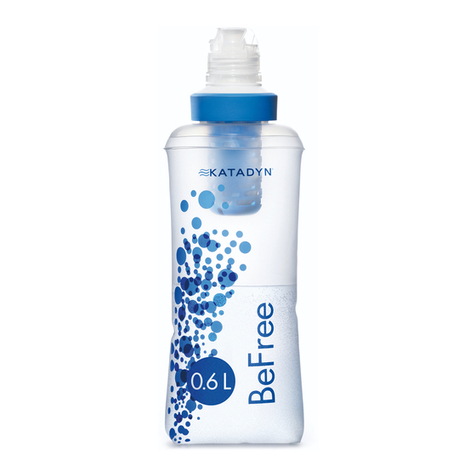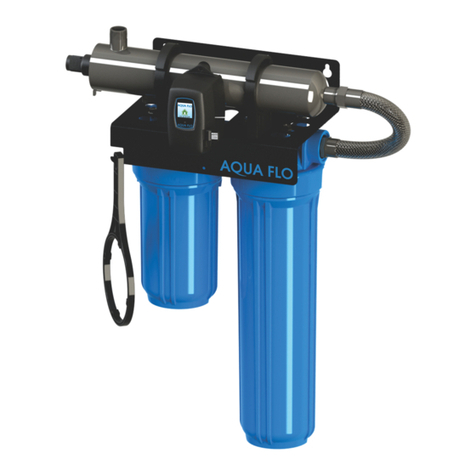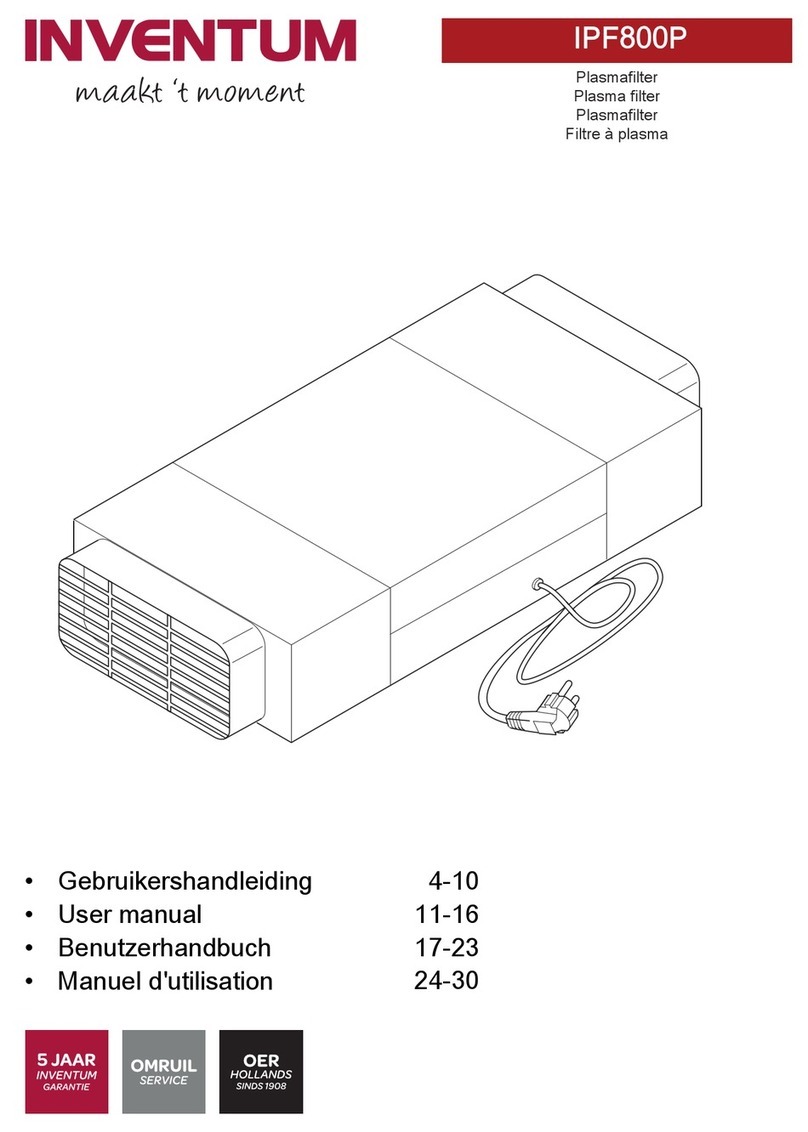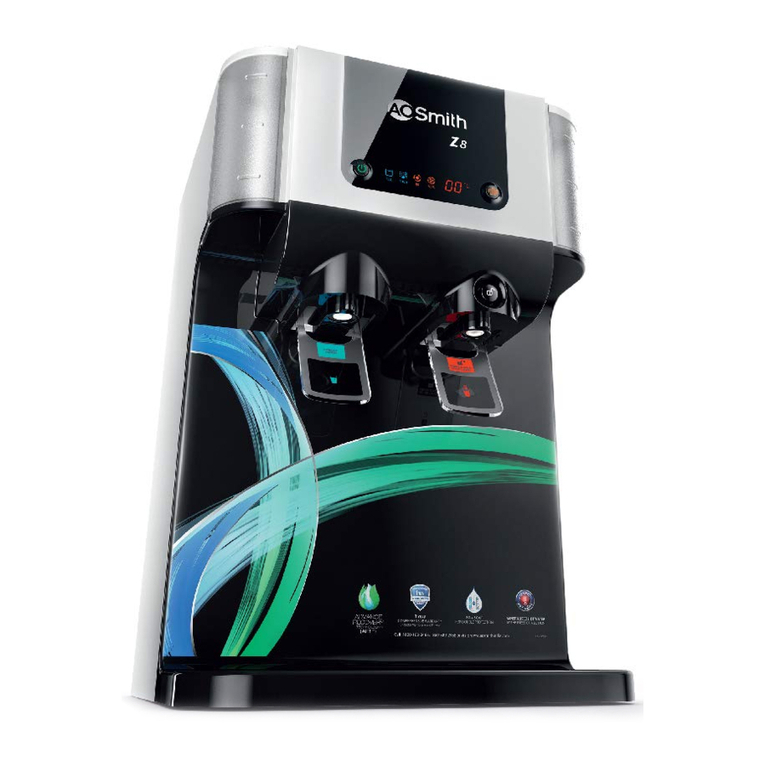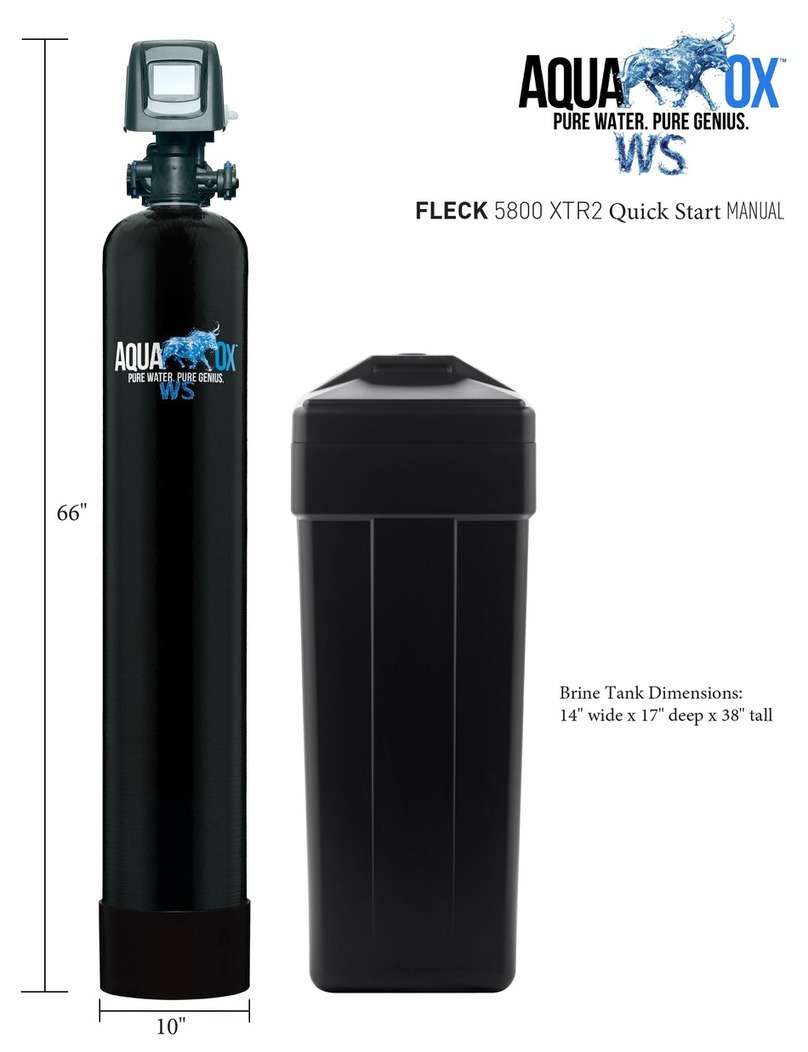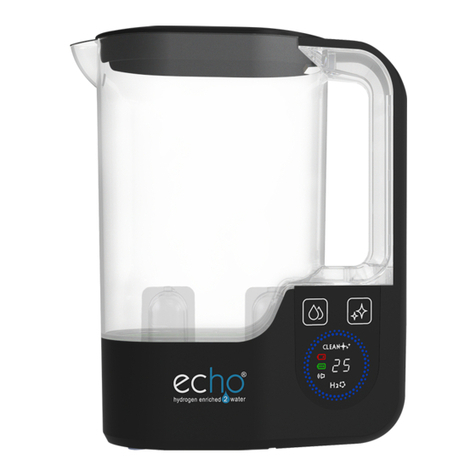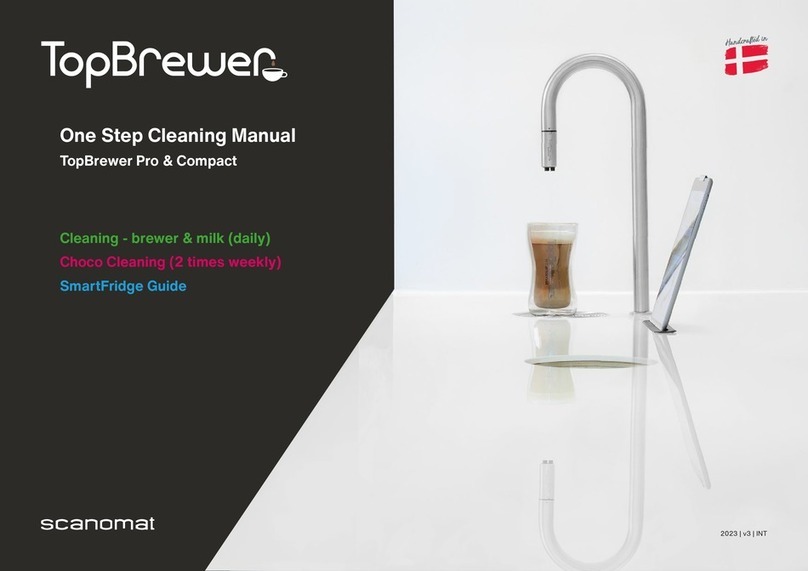MAC AVR Instruction manual

Publication: MAN3002G Revision Date: 09/15/08
MAC EQUIPMENT,INC.
P.O. BOX 205
SABETHA,KS 66534
SALES,PARTS &SERVICE:1-888-821-2476
www.macequipment.com
AVR DUST FILTER
INSTALLATION, OPERATION
& MAINTENANCE MANUAL


TABLE OF CONTENTS
DESCRIPTION PAGE
General Introduction.............................................................. 1
Safety ................................................................................... 1
Principle of Operation............................................................ 3
Installation............................................................................. 4
System Start Up and Operation............................................. 9
Maintenance ......................................................................... 9
Troubleshooting.................................................................... 18
Spare Parts........................................................................... 19
LIST OF FIGURES Page
Figure 1-1 Typical AVR Dust Filter (radial inlet type).............1
Figure 1-2 Typical AVR Dust Filter
(pneumatic receiver type)....................................1
Figure 2-1 Lockout and Tagout of
Electrical Service and Compressed Air..................2
Figure 2-2 Typical Location of Safety Decals ........................2
Figure 2-3 Typical Locations of Safety Decals
For Explosion Vents............................................3
Figure 3-1 Principle of Operation...........................................3
Figure 4-1 Typical Support Structure.....................................4
Figure 4-2 Filter and Support Structure.................................4
Figure 4-3 Typical Rupture Style Explosion Vent...................5
Figure 4-4 Location of Ductwork and Accessories.................5
Figure 4-5 Timer Control and Wiring .....................................6
Figure 4-6 Installation of Differential Pressure Gauge ...........6
Figure 4-7 Jumpers and Wiring of the Photohelic
Switch/Gauge.....................................................7
Figure 4-9 Drip Leg (supplied by customer)...........................8
Figure 6-1 Replacement of Standard Nylon
Venturi .............................................................. 10
Figure 6-2 Replacement of Optional Cast
Aluminum Venturi............................................... 11
It is the owner's responsibility to maintain the safety features included with this equipment.
The safety features may include, but not necessarily be limited to: guards, access doors
and covers, explosion vents, warning decals, caution decals, and advisory decals.
Replacement safety features are available from MAC Equipment, Inc.
DO NOT attempt to operate this equipment until you have read and understood the
contents of this manual. If you do not understand the contents of the manual bring it to
the attention of your supervisor. This manual contains important safety instructions
concerning the maintenance, use, and operation of this product. Failure to follow these
instructions may result in seriou
s injury or death.
NO haga funcionar este equipo hasta haber leido y comprehendido el contenido de este
manual. Si aiguna partre del contenido del manual queda sin comprehender, notifiqueselo
a su supervisor. Este manual contiene instrucciones importantes en cuanto al
anterimiento, uso, y funcionamiento sequros de este producto. El no seguir las
instrucciones contenidas en este manual podria ocasionar lesiones graves.

Publication: MAN3002G MAC Equipment, Inc. 1
GENERAL INTRODUCTION
Congratulations on your selection of a MAC AVR Dust Filter. As the
owner/operator of this unit you have an important responsibility to see
that it is operated and maintained in a safe manner. The unit will require
very little attention to keep it in good operating condition. This manual
has been prepared to aid you in that effort.
Throughout this manual, reference may be made to various components
which may or may not be part of your particular system. They are
included in the interest of fully describing typical AVR filter systems.
2 LIFTING LUGS DIAPHRAGM
VALVES AIR HEADER TIMER CONTROL
PANEL
1/8" FNPT
PORTS
OPPOSITE
SIDE
AIR INLET
HINGED
SERVICE
DOOR
OPTIONAL
SUPPORT
STRUCTURE OPTIONAL
AIRLOCK
AIR OUTLET
Figure 1-1 Typical AVR Dust Filter (radial inlet type)
2 LIFTING LUGS DIAPHRAGM
VALVES TIMER CONTROL
PANEL
HINGED
SERVICE
DOOR
OPTIONAL
SUPPORT
STRUCTURE
OPTIONAL
AIRLOCK
AIR OUTLET
INLET
AIR HEADER
1/8" FNPT
PORTS
OPPOSITE
SIDE
Figure 1-2 Typical AVR Dust Filter (pneumatic receiver type)
Receiving Your Equipment
As soon as the equipment is received, it should be carefully inspected to
make certain the unit is in good condition and all items listed on the
packing list are received. Even though the equipment is mounted on
heavy shipping skids at our plant it is possible for it to be damaged in
shipment. All damages or shortages should be noted on the Bill of
Lading. The purchaser must take immediate steps to file reports and
damage claims with the carrier. All damages incurred to the unit in transit
are the responsibility of the common carrier since it is the policy of MAC
Equipment, Inc. to make shipment F.O.B. from its factory. Ownership
passes to purchaser when the unit is loaded and accepted by carrier.
Any claims for in transit damage or shortage must be brought against the
carrier by the purchaser.
If the unit is not going to be assembled and installed soon after arrival, it
should be stored in a warm, dry location to protect against corrosion.
Filter bags and cages or cartridges must be stored in a dry, rodent proof
location.
SAFETY INFORMATION
Recognize Safety Information
Understand Signal Words
DANGER !
Indicates an imminently hazardous situation which, if not avoided, will
result in death or serious injury.
WARNING !
Indicates a potentially hazardous situation which, if not avoided, could
result in death or serious injury.
CAUTION !
Indicates a potentially hazardous situation which, if not avoided, may
result in minor or moderate injury and/or property damage.
Warning Decals And Guards
This piece of equipment contains several warning decals located in many
different locations. It is the owner/operator’s responsibility to maintain the
integrity of these decals and to ensure that all operators of the equipment
are aware of them and understand their meaning. Replacement decals
are available free of charge from your MAC Equipment Service
Representative, or by calling MAC Equipment Inc. at 1-888-821-2476.
This piece of equipment may contain one or more safety guards to
protect the operator(s) from injury. It is the owner/operator’s
responsibility to maintain the integrity of these guards and ensure that
they are in place when the equipment is in operation.
Lockout-Tagout Requirements
Do not attempt to operate or maintain this piece of
equipment until you have read and thoroughly
understood all of the safety information contained
in this manual. All such information must be
taken seriously. This piece of equipment contains
moving parts and potential pinch points which
can cause serious injury or death. If you do not
understand anything in this manual seek
assistance from your supervisor before operating
this equipment.
WARNING!
The symbol at left
is used to alert you to important
safety messages located throughout this manual. It
also appears on the equipment to alert you to
potential hazards. When you see this symbol you
must read, understand, and heed the information
that accompanies it.
DO NOT attempt to operate this equipment
with any guard removed. Replace damaged
guards.
Before inspecting or servicing this equipment
perform an approved lockout-tagout procedure
on the electrical service, the compressed air
(or other gas) supply, or any other energy
source.

Publication: MAN3002G MAC Equipment, Inc. 2
ELECTRICAL POWER COMPRESSED AIR OR GAS
Figure 2-1 Lockout and Tagout of Electrical Service and
Compressed Air (or other gas)
Control of this equipment must be in accordance with OSHA Standard
1910.147 "The control of hazardous energy (lockout-tagout)". This
standard "requires employers to establish a program and utilize
procedures for affixing appropriate lockout devices or tagout devices to
energy isolating devices and to otherwise disable machines or equipment
to prevent unexpected energizing, start-up or release of stored energy in
order to prevent injury to employees".
For further information on Lockout-Tagout requirements, see your
company's Safety Director or refer to OSHA Standard 1910.147.
Safety Precautions
Guards, access doors, and covers are in place and secure.
The equipment has been wired and grounded in accordance with all
applicable codes.
If air being filtered contains toxic materials all necessary precautions
to protect personnel have been taken.
An approved lockout-tagout procedure has been followed before the
equipment is inspected, disassembled, and/or serviced. The
equipment is automatically controlled and may start without warning
unless energy supplies are properly disconnected and locked out-
tagged out.
The control panel enclosure is closed and secured except as is
necessary for service or adjustment.
The service door is closed and secured. Do not enter filter while the
system exhaust fan is operating; air flow can pull service door
closed, trapping personnel inside.
A confined space permit, if required by authorities having
jurisdiction, has been obtained prior to personnel entering the unit.
Check with your company’s safety director for special instructions,
testing prior to entry, etc. that may be required by the specific
application.
Explosion vents have been properly installed and ducted, as
described below in the Installation section.
Do not cut, weld or grind on the filter while it is in operation; dust
laden air may be highly explosive. Refer to the proper National Fire
Protection Association Manual for information on cutting, welding or
grinding in hazardous areas.
The work area is clean and orderly, free of debris, materials, tools,
etc.
Operating personnel are wearing proper ear and eye protection and
have secured loose hair, clothing, jewelry, etc.
Read and Understand Safety Decals
Several safety labels are located on this piece of equipment to warn the
operator(s) of potentially hazardous situations.
Decal Locations
The following figure shows typical locations for safety decals on the AVR
filter. The locations of decals for your particular filter may vary from those
indicated. Inspect your filter for locations of all decals.
E
G
F
A
B
D
C
Figure 2-2 Typical Locations of Safety Decals
Safety Decals
Safety decals (and other information labels) may include, but are not
necessarily limited to, the examples shown below. Locate all of the
safety decals on your equipment and know their meaning prior to
operating this dust filter. Free replacement decals are available; ask for
decal kit P/N 00413468.
A.
End User must determine
hazard level for entry permit
requirements.
B.
Equipment has moving
blades, shaft, rotor or arm
which may cause injury. It
may also have valves
discharging compressed
gases.
C.
Equipment can start without
warning. Exhaust fan can
create enough force to close
and hold service door closed.
Failure to follow these instructions may result
in death, personal injury, and/or property
damage!
Do not operate, inspect, or service this
equipment unless all the following safety
precautions are in effect:

Publication: MAN3002G MAC Equipment, Inc. 3
D.
Typical MAC Equipment, Inc.
nameplate.
E.
Match-mark arrows to assist
in aligning upper and lower
sections of the AVR filter
assembly.
F.
Equipment piping and/or
valves are under pressure.
Servicing while pressurized
can cause injury.
G.
Typical MAC Equipment logo
In addition, if your filter is equipped with an explosion vent the following
figure shows typical locations for other safety decals.
RUPTURE
STYLE
EXPLOSION
VENT
II
Figure 2-3 Typical Locations of Safety Decals for Explosion Vents
I.
Stay clear of explosion vent.
During an explosion, flame,
explosive gases or flying
material will be released.
The following ISO decals may appear on your AVR Filter:
Disconnect, lockout and tagout
electrical and all other energy
sources before inspecting, cleaning
or performing maintenance on this
filter.
This warning sign reminds
operators and other users that they
must read and understand the
Operator Manual before storing,
installing, inspecting, cleaning or
servicing the filter.
This filter may be remotely
controlled. It can start without
warning unless it is properly locked
out at the motor starter or local
disconnect. Do not rely on the
control system for safe lockout.
Equipment can start without
warning. This access port should
be equipped with safety lock.
PRINCIPLE OF OPERATION
The AVR filter is a bottom bag removal, automatically controlled, reverse
air pulse cleaning dust filter. AVR models are rated for 17" Hg. or 40”
H20 in sizes ranging from the 18AVR7 with 13 sq. ft. of cloth to the
96AVR80 with 983 sq. ft. of cloth.
DUST LADEN
AIR IN
CLEAN AIR
OUT
COMPRESSED
AIR HEADER
CLEANING
PULSE FILTER BAGS
HOPPER
TUBESHEET
COMPRESSED
AIR SUPPLY
PRODUCT DISCHARGE
Figure 3-1 Principle of Operation
Air Flow through the Unit
Dust laden air enters the AVR near the bottom of the unit. Rows of filter
bags are mounted on a horizontal tubesheet and suspended in the filter
housing. A remote fan on the exhaust side draws air through the filter.
Filtered dust collects on the outside of the filter media, and falls into the
hopper where it can be collected. Filtered air passes through the center
of the filter bags and out through the clean air discharge at the top of the
unit.
Pulse Cleaning
An air pulse cleaning system cleans the filter bags and dislodges filtered
product so that it drops into the hopper. A system of compressed air
manifolds is mounted above the bank of filter bags. A pulse of
compressed air is periodically directed downwards through the bag. The
pulse flexes the filter bag, causing accumulated dust to be dislodged and
fall to the hopper below.
The cleaning pulse is controlled by a solid state electronic timer which
automatically sequences through the bank of filter bags, one row at a
time. The timer can be set to operate at a predetermined interval.
The pulse can also be controlled by a photohelic differential pressure
switch/gauge which responds to pressure differences across the filter.
When controlled by the switch/gauge, cleaning occurs only when needed,

Publication: MAN3002G MAC Equipment, Inc. 4
decreasing air consumption and increasing filter bag life by avoiding
unnecessary pulsing.
Air Exhaust
Returning filtered exhaust air into a facility can present hazards. The
type of dust, its characteristics and the effect of a recirculation system
malfunction must be considered. If system design dictates that filtered air
be returned into the facility, the buyer is cautioned to take appropriate
steps to monitor the air quality and provide appropriate safeguards as
prescribed by OSHA, NFPA, Federal, State and Local codes and
regulations.
INSTALLATION
The AVR filter housing and internal components are shipped factory
assembled. The hopper, unassembled support structure (if provided),
magnehelic or photohelic pressure gauges, bags and cages, service
platform and ladder/safety cage (if provided) are shipped loose and
require field assembly.
Location
Locate the AVR filter in a clear area away from normal personnel traffic
on a flat and solid concrete or steel surface. Locate the filter so as to
minimize supply and exhaust ductwork and so that explosion venting, if
required, can be directed so that injury to personnel and damage to
property cannot occur. Provide sufficient space for emptying the hopper
and maintaining the unit.
Foundation
The filter requires an adequate foundation, designed by a qualified
structural engineer. Refer to the General Dimension drawings of your
system for foot pad layout and weights. When calculating the loading for
the foundation, the weight of the filter, material collected, and all auxiliary
equipment must be considered together with snow, wind and seismic
loads.
Support Structure
A support structure may be supplied by MAC Equipment, Inc. as part of
your AVR filter system. The figure below shows a typical structure, which
will vary from system to system depending on the size of the AVR filter.
Figure 4-1 Typical Support Structure
To install the support structure:
1. Review the components of the support structure.
2. Loosely assemble the structure. Do not tighten any bolts until all
assembly is complete.
3. Set anchor bolts in the foundation according to the plan drawing.
Position the legs on anchor bolts. Attach the cross bracing with
A325 3/4" or 5/8"UNC (as provided) bolts, lock washers and nuts.
4. Tighten all bolts. Bolts must be tightened before allowing the
structure to support the weight of the filter.
5. Touch-up paint on the support structure as needed. Assembly
should be complete and all bolts tightened prior to painting.
Setting in Place
It is recommended that a properly sized crane be used for unloading the
filter and setting it in place.
SUPPORT
STRUCTURE
HOPPER
FILTER
HOUSING
CLEAN AIR
PLENUM
TUBESHEET
Figure 4-2 Filter and Support Structure
To set up the AVR filter:
1. Position the hopper on the support structure and fasten the hopper
to the support structure with 1/2" UNC x 1 1/2" long bolts, lock
washers and nuts.
Note: Occasionally, due to shipping limitations, the clean air plenum,
tubesheet, and filter housing are shipped unassembled. If so, apply
silicone caulk to flanges, match alignment notches on tubesheet and
flanges, and bolt together with 3/8”UNC x 3/4”long bolts.
2. Apply silicone caulk to the hopper flange in a figure eight pattern
around the bolt holes.
3. Lift the filter housing and set in place on the hopper. Bolt the
housing and hopper together with 3/8" UNC x 1-1/2" long bolts, lock
washers and nuts. Tighten all bolts before removing the crane.
Explosion Venting
Venting Guidelines
This section is intended as a general guide only: For further information
refer to NFPA Standard 68, "Explosion Venting" and consult with your
insurance carrier.
Explosion venting is required whenever the filter will
process explosive dusts as defined by NFPA.
Dust filters handling explosive dusts should be located
outside of buildings wherever possible.
Explosion vents must not be obstructed in any way and
must be protected from snow/ice buildup. Explosion vents
must be oriented so that flame, explosive gases, or flying
material cannot injure personnel or damage property.
Dust filters inside of buildings should be located next to an
exterior wall; the explosion vent(s) must be ducted to the
outside of the building. Vent ducts must be kept as short
During an explosion, a vent will release flame,
explosive gases or flying material. The
explosion venting must be directed away from
personnel to prevent injury.
Spreader bars are recommended to distribute
the load evenly while lifting the filter.
Never return filtered air to a habitable space
or building without proper monitoring and
precautions.

Publication: MAN3002G MAC Equipment, Inc. 5
and straight as possible, avoiding bends. Such ducts must
be capable of withstanding a pressure at least as high as
that expected to develop inside the filter itself in the event
of an explosion. Ducts increase internal pressures inside
the filter, and special reinforcement of the filter may be
required. Consult MAC Equipment, Inc. Engineering
Department regarding your specific application.
Any duct will decrease the effectiveness of the vent.
Explosion Vents-General
Explosion vents are available from MAC Equipment Inc., in domed
rupture panel styles as part of the filter system. The rupture panel style
functions by bursting the panel itself. Explosion vents are installed after
the filter unit is assembled on its support structure.
Installing Domed Rupture Panel Style Vents
The installation of the rupture panel style vent should be performed by
two people.
Refer to Figure 4-3 below.
Figure 4-3 Typical Rupture Style Explosion Vent
1. Remove the hold-down frame from the vent mount on the side of the
filter.
2. Carefully remove the rupture style vent panel from the crate
(CAUTION! Edges of the vent panel are sharp!) Avoid excessive
flexure of the vent.
3. Place the vent panel over the protruding bolts in the housing wall.
The vent panel must be oriented correctly. The panel ruptures on
three sides and hinges on the fourth. The hinge side is indicated by
a v-notch in the edge. Place the panel with the v-notch to the left
and the I.D. tag at the bottom as shown in Figure 4-3. The dome
must protrude outward as shown or the panel will not function.
4. Place the hold down frame over the bolts, making sure that an even
pressure is brought to bear on the panel.
5. Tighten nuts evenly and use an alternating pattern to prevent
damage to the vent panel. Tighten nuts to 20-25 ft. lbs. of torque. It
is not necessary to use an excessive amount of pressure to clamp
the panel securely.
Ductwork and Accessories
CLEAN AIR
DUCT
TIMER
CONTROL
AIRLOCK OR
OTHER OUTPUT
ACCESSORY
RADIAL INLET
PNEUMATIC
RECEIVER
INLET
Figure 4-4 Location of Ductwork and Accessories
1. Connect the inlet duct to the radial or pneumatic receiver inlet on the
filter.
2. Connect the clean air duct to the exhaust located at the top of the
filter housing. Ductwork must be constructed to withstand the
system design pressure. The ductwork must be independently
supported; the AVR filter is not designed to support ductwork.
3. Attach any auxiliary equipment (such as an airlock or screw
conveyor) to the discharge flange of the hopper.
Electrical Controls and Wiring
The filter is supplied with NEMA 4 electrical solenoids and timer control.
A NEMA 7 or 9 option is available. The timer is protected by a board
mounted fuse. Refer to the label on the timer control for power
requirements.
Timer Control Logic
Input power is applied to the timer control at all times that the AVR filter is
in operation.
“Continuous”cleaning occurs if the “Pressure Switch”contacts on the
timer board are jumpered; if so, cleaning will occur whenever the system
is energized, and is controlled by an electronic timer.
When energized, the timer begins the “time-off”part of its cycle. At the
end of the “off”period, the control energizes solenoid Number 1 to
provide a timed cleaning pulse to the first row of bags. At the end of the
pulse the “time-off”period begins again; when it ends the control
energizes solenoid Number 2. The control cycles through each of the
solenoids in turn, providing a cleaning pulse to each row of filter bags.
The process continues as long as the system is energized. The durations
of the cleaning pulse (“time-on”)and “time-off”are both adjustable. A
program wire allows for field selection of the number of solenoids.
For “on demand”cleaning, the pressure switch contacts are wired to a
remote photohelic switch/gauge or other pressure sensing device.
Cleaning occurs as above as long as the remote contacts on the
switch/gauge are closed. When they open the cleaning operation stops.
When the contacts close again the control remembers the last solenoid
activated and resumes the cleaning cycle with the next one in line.
Excessive tightening may damage fasteners
or the explosion vent panel.
Only trained and authorized persons should be
permitted to service or maintain electrical
components. It is the buyer’s/installer’s
responsibility to ensure that all applicable
electrical codes are met.

Publication: MAN3002G MAC Equipment, Inc. 6
Timer Control Wiring and Adjustment
Refer to Figure 4-5 and to the timer manufacturer’s documentation.
Figure 4-5 Timer Control and Wiring
1. Open the timer enclosure and connect the electrical service to the
terminals labeled L1 and L2. If a photohelic switch/gauge (or other
pressure switch) is not used, connect a jumper wire across the
terminals labeled “Pressure Switch.”Do not connect power to the
Pressure Switch terminals; the timer board will be damaged.
2. Check both the "Time-on" and the "Time-off" settings. "Time-on"
determines the duration of the cleaning air blast and should be set at
60 milliseconds. The 60 milliseconds "Time-on" has been
determined as the optimum duration for the majority of applications
and should not be changed unless directed by MAC Equipment, Inc.
Set the "Time-off" to 15 seconds; this is the length of time between
successive cleaning pulses. For example, if the filter has six rows of
bags, each row would be cleaned every 90 seconds, 6 x 15
seconds. After operating experience has been gained, the "Time-
off" setting may be adjusted to the maximum time possible that will
maintain effective bag cleaning, which will conserve compressed air.
When a photohelic differential pressure switch/gauge is used, only
the pressure settings should be adjusted instead of the "Time-off"
setting. Effective bag cleaning is directly related to the differential
pressure. Refer to the Operation Chapter for more information
about differential pressure and adjustment of the switch/gauge.
3. Check the program wire on the timer board to be sure it is
connected to the pin that corresponds with the number of solenoid
valves mounted on or in the timer enclosure.
4. Energize the electrical service to the timer. The "Power On" light
should be illuminated and the unit should start pulsing. If a
photohelic switch/gauge is in use, the high pressure setting on the
switch/gauge must be set to zero to start pulsing. After pulsing is
confirmed, restore the setting to its previous value.
5. De-energize the system as soon as pulsing has been verified;
pulsing the solenoids without the compressed air supply for any
extended period of time can damage the solenoid valves.
Other Electrical Connections
Make electrical connections to the motor(s) on any auxiliary equipment
such as an airlock, screw conveyor or fan. Verify that all motors are
rotating in the proper direction.
NOTE: The motors should be interlocked such that they start in the
following sequence: (1) airlock, (2) AVR timer, and (3) main exhaust fan.
The motors should be shut down in the reverse order. Shut down the
exhaust fan first; using an adjustable time delay (0-15 minutes) shut
down the timer 15 minutes after the exhaust fan. Finally, shut down the
airlock.
If the filter is being used to vent a gas fired dryer, to prevent fires and
explosions, the main exhaust fan must be interlocked with the gas burner
in such a way as to allow the fan to operate an adequate period of time to
purge the dust collector of combustible gases before turning on the
burner. The installation of a gas detection device in the system should be
investigated and evaluated for each application.
Magnehelic Gauge or Photohelic Switch/Gauge
A magnehelic differential pressure gauge is available as an option. The
gauge indicates the difference in pressure between the input and
discharge sides of the filter. An excessively high reading indicates that
filter media are becoming clogged and that more frequent cleaning pulses
are required.
A photohelic switch/gauge is a second option. The photohelic
switch/gauge indicates differential pressure and controls the cleaning
operation. When an electronic circuit in the switch/gauge detects
differential pressure in excess of a predetermined set point, it provides a
dry contact closure which initiates the cleaning cycle. When differential
pressure drops to a predetermined set point, the switch/gauge opens the
contact, thus stopping the cleaning cycle. This method of control reduces
compressed air needed and increases bag life.
To install either type of gauge refer to Figure 4-6 and to the
manufacturers documentation.
HIGH PRESSURE
PORT
(
OPPOSITE SIDE
OF MACHINE
)
LOW PRESSURE
PORT
(
OPPOSITE SIDE
OF MACHINE
)
GAUGE
Figure 4-6 Installation of Differential Pressure Gauge
Installing the Magnehelic Differential Pressure Gauge
1. Mount the gauge in a convenient place for easy viewing.
2. Install the tubing fittings in the pressure ports of the magnehelic
pressure gauge and in the ports on the filter. The filter ports are
normally located on the right side of the filter from the service door.
3. Run the plastic tubing supplied from the filter ports to the gauge
ports. The low pressure line runs from the filter port above the tube
sheet to the low pressure port (usually the lower port) on the gauge.
The high pressure line runs from the filter port below the tube sheet
to the high pressure port (usually the upper port) on the gauge.
4. Verify that the filter is installed inside the housing on the high
pressure port.
Installing the Photohelic Differential Pressure Switch/Gauge
Install the photohelic switch/gauge and run air piping as for the
magnehelic gauge as described above.
In addition:
1. Connect electric power to contacts labeled ‘L1’and ‘L2’on the
switch/gauge. Refer to the label on the switch/gauge for power
requirements.
2. Connect contacts labeled “NO”and “C”on the switch/gauge to
contacts labeled “Pressure Switch”on the timer board. (Remove
jumper between the Pressure Switch contacts, if any.)
3. Install jumpers on the switch/gauge according to the Figure 4-7
below.

Publication: MAN3002G MAC Equipment, Inc. 7
Figure 4-7 Jumpers and Wiring of the Photohelic Switch/Gauge
Bag and Cage Installation
Filter bags and cages are shipped loose and are installed after the AVR
filter has been assembled and set in place. Installation of bags and
cages is made from inside the unit.
Install bags and cages as follows:
1. Be sure the bag cage has a bottom cap. Slip the bag over the bag
cage, centering the seam 1-1/2 or 2" either side of the slot at the top
of the bag cage.
2. Fold the remainder of the bag over the top of the cage. Make sure
the cloth on the inside of the cage extends below the ring on cage
top. Smooth out all folds on interior. If the bag is equipped with a
grounding strip see ground strap installation instructions.
3. Slide the bag and bag cage on to the bag cup until the top of the bag
is approximately 1/8”from the tube sheet.
4. Make sure ring on cage will fit into corresponding groove on the bag
cup. Squeeze cage together and slide up and down. You will be
able to tell if ring and groove are aligned.
Installation Instructions: MAC Bags With Grounding Straps
for Grounding Metal Cages
Proper installation of bags and cages is required to ensure that the metal
cages are not isolated from ground with the tubesheet (cell plate) in
applications that have potential for an explosion hazard.
Section A: Bag Installation
A grounding strap at the top of the bag is intended to ground the cage
and clamp to the grounding lug on the tubesheet. Ensure that the bag
cup/venturi is cleaned to remove dust and corrosion buildup. Position the
cage in the bag so that the split in the cage top is located at 90 degrees
from the seam on the bag. This will ensure that the grounding strap will
not be located in between the split. Tuck the bag top into the cage top
and install bag, cage, and clamp per the instructions in the bag and cage
installation section.
The effectiveness of a grounding mechanism
depends upon proper installation and connection
of the grounding mechanism to an adequately
collector component. Failure to properly install
and connect grounding mechanism or maintain
grounding of the collector component may result
in static electricity discharge and possible
explosion of dust stream within the collector and
serious property damage and/or bodily injury.
Proper installation must be verified per Section B
of these instructions prior to operating collector.
The bag cup is made from an insulative material,
which requires the attachment of the free end of
the grounding strap to the provided grounding
lug. This provides a grounding path for the metal
cage and clamp components.
1/8”
Grounding strap
Grounding strap

Publication: MAN3002G MAC Equipment, Inc. 8
Section B: Verification of Proper Grounding
Proper installation must be confirmed by testing to verify 1x106 (1
megohm) maximum resistance at 500 volts between cage and tubesheet
(cell plate).
Bottom load collector: testing resistance between cage and
tubesheet
In addition to the proper installation and grounding of bags and cages,
the end user should select an appropriate filter media for use in bags.
Refer to the National Fire Protection Association (NFPA) “Recommended
Practice on Static Electricity,”NFPA 77-2000 edition for more information
(www.nfpa.org).
Compressed Air Requirements
Compressed Air
For most applications, compressed air at 80-100 PSIG at the filter header
is adequate for proper cleaning of the filter bags. Pressures between
100-120 PSIG may be appropriate for some critical applications.
Operations at pressures above 100 PSIG should be reviewed with MAC
Equipment Inc. for approval and recommendations. Compressed air
pressures below 80 PSIG require special considerations in the design
and sizing of the filter and also should be reviewed with MAC.
Compressed Air Quality
Trouble free, maintenance free operation is largely dependent on
providing clean, dry, oil free compressed air. The importance of clean,
dry, oil free compressed air cannot be over emphasized. Dirt, rust and
scale can prevent diaphragm valves from operating properly. Moisture
can cause valves to freeze in cold weather. Moisture and oil can cause
deterioration of the valve diaphragms, and if the interior of the filter bags
become coated with moisture and/ or oil, eventual plugging of the filter
media can occur.
The degree to which a compressed air system must be provided with
safeguards to eliminate dirt, scale, moisture, and oil, will depend on the
type of compressor, aftercoolers, receivers, and accessory equipment
chosen or available, the piping material used, the piping layout between
the compressor and the dust collector compressed air header, the lowest
temperature to which the piping will be exposed, and the type of process
and process conditions encountered.
Clean Compressed Air
1. A simple drip leg installed at the point where the air line connects to
the compressed air header is usually sufficient to trap small amounts
of dirt, rust, and scale, and to serve as a low point to drain moisture
when a shutoff valve is installed.
AIR HEADER
AIR SUPPLY
TO DRAIN
Figure 4-9 Drip Leg (supplied by customer)
2. An in-line filter or a centrifugal separator is required where large
amounts of dirt, rust and scale are present, and especially where a
possible shut down of the system is critical.
Dry Compressed Air
Liquid Moisture Traps:
1. An automatic moisture drain should be installed on the compressed
air receiver. Automatic drains are available in a variety of float
operated types, piston types and pilot types.
2. Small amounts of liquid moisture can be handled with in-line air
filters with automatic drains.
3. Large amounts of liquid moisture require a centrifugal separator
followed by a chemical dryer (consumable desiccant requiring
replacement) to filter out the water droplet carry over. The dew point
is dependent on the temperature of the cooling water used at the
after cooler.
Tubesheet
Plastic bag cup
Terminal attached to grounding lug
Grounding strap
Clamp
Grounding strap
Terminal

Publication: MAN3002G MAC Equipment, Inc. 9
Compressed Air Dryers:
1. In applications where the compressed air piping is indoors or where
the installation is in a warm or moderate climate and a compressed
air dew point of 35to 50F is sufficient to prevent moisture
condensation in the pipe lines, the following types of equipment are
available: the deliquescent desiccant non-regenerative type for
small to medium volumes of air, and the mechanical refrigeration
type with or without an after warmer for large volumes of air.
2. In applications where the compressed air piping is outdoors or
where the installation is in a cold climate and a compressed air dew
point of-10F to -40F is required to prevent moisture condensation
in the pipe lines, the following types of equipment are available: the
in-line desiccant type with manual regeneration for small volumes of
air; the desiccant type with heatless automatic regeneration for
medium volumes of air; and the dual tower desiccant type with
automatic regeneration by heat for large volumes of air.
Oil Free Compressed Air
1. Much of the above mentioned equipment used to remove liquid
moisture can also be used to remove condensed oil and oil mist.
2. For installation where condensed oil and oil mist are the major
problems, special in-line filters are available that use desiccant
absorptive elements or packed beds of an oil absorbing granular
organic polymer.
Compressed Air Piping
The compressed air header on the AVR filter should be connected with at
least 1" diameter pipe. The air piping for multiple units should be sized in
relation to air consumption. A drain should be installed at the lowest
point in this piping.
The following table is a guideline for selecting the proper pipe size and is
based on 80-100 PSIG air.
Recommended Piping Sizes
Total Free Air Consumption
Pipe Length Up to 50 SCFM 50 - 100 SCFM
up to 100 ft. 1" dia. 1-1/4" dia.
100 to 500 ft. 1-1/4" dia. 1-1/2" dia.
500 to 1000 ft. 1-1/2" dia. 2" dia.
Air Volume Requirements
The AVR filter typically requires the following SCFM at 80 to 100 PSIG:
Model Number SCFM Required
AVR 7 3.3
AVR 14 4.7
AVR 21 5.4
AVR 32 6.5
AVR 39 7.5
AVR 52 9.1
AVR 62 10.6
AVR 80 13.2
SYSTEM START-UP AND OPERATION
The following inspection should be made before the initial start-up of the
system and for normal operation thereafter.
1. Check filter bags for proper installation.
2. Check all air and electrical connections for proper routing. The
compressed air supply should be connected to the 3/4" FNPT port
on the air header. Turn on the compressed air supply to the header.
Pressure should be 80-100 PSIG.
3. Check out and start up any auxiliary equipment such as an airlock,
screw conveyor, or fan and see that any control interlocks are
operating properly.
4. Energize the timer panel. Listen for the sound of pulsing of the
solenoids and diaphragm valves to verify that they are operating. (If
the filter is equipped with a photohelic gauge, decrease the high
pressure setting on the gauge to zero to activate the timer. Restore
the pressure setting to its normal value after pulsing is verified.)
5. When all components are operating correctly, start the dust laden air
through the filter and observe the differential pressure at the gauge.
(The differential pressure is the air resistance across the filter bags).
The pressure should stabilize between ½" and 4" H2O. Never allow
pressure drop across the filter to exceed 17" H2O; this may damage
the bag cages.
6. If the pressure continues to rise over 5" H2O and does not stabilize,
shut off flow of dust laden air and decrease the "time-off" setting by
one-half the initial setting. This will result in a more frequent
cleaning cycle. Restart the system.
7. When collector stabilizes between ½" and 4" H2O, you may then
"fine tune" for least air consumption by gradually increasing "time-
off" setting. Do not exceed 4" to 5" H2O on clean bags because as
the filter bags become "dirty" the differential pressure will increase.
Note: If a photohelic switch/gauge is in use, do not change the
"time-off" setting. (With the photohelic gauge the cleaning cycle is
initiated by pressure differential, not time.) Set the pressure set
points on the photohelic switch/gauge at 1.5" H2O for the low
pressure setting and 4" H2O for the high pressure setting. If the unit
pulses continually, decrease both pressure set points to lower the
differential pressure and initiate the cleaning cycle sooner.
MAINTENANCE
It is recommended that one individual be assigned to monitor the
operation of the dust-collection system. The individual assigned should
have maintenance manuals and manufacturer’s documentation for all
components readily available. He(she) should be thoroughly familiar with
the manuals so as to be able to pinpoint trouble should it occur.
The individual responsible for the system should follow a regular
schedule of inspection and maintenance. The exact schedule will
depend on the particular system and the number of hours it operates per
day or week. A typical maintenance schedule is shown below.
Disconnect and properly lockout-tagout the
electrical and compressed air service before
performing any maintenance or service
procedures on the filter.
Disconnect and properly lockout-tagout the
electrical and compressed air service before
performing any inspection procedures.

Publication: MAN3002G MAC Equipment, Inc. 10
Sample Maintenance Schedule
Weekly
1. Check and record magnehelic (or photohelic) gauge readings on all
filters. Adverse operating conditions can be detected by a change in
pressure drop.
2. Check for dust in clean air outlet from filter.
3. Check filter hoppers for continuous discharge of dust.
4. Open petcock to check for moisture in the compressed air header.
5. Listen to the diaphragm valves and verify that each row of bags is
being cleaned.
6. Check fan and motor bearings for excessive heat or vibration.
7. If pressure pneumatic conveying equipment is used to dispose of
dust, check the positive displacement pump for vibration,
overheating, and proper lubrication. Also, compare reading on the
pressure gauge with previous readings. Clean air-inlet filter or
replace as necessary. It is important to follow the manufacturer's
recommendation on equipment of this nature.
8. Check explosion vent(s) (if provided) for damage (broken bolts or
damaged panel).
Monthly (or at manufacturer's recommended intervals)
1. Check the filter bags for signs of excessive wear or damage.
2. Drain condensation from air reservoir. Check the compressed air
dryer and filter for proper operation.
Six Months
1. Check for evidence of moisture or dust buildup inside the filter
housing.
2. Check operation of solenoids and diaphragm valves.
3. Check oil in all gear motors. Do not overfill.
4. Check belt tension on all V-belt drives.
Bag Replacement
The filter bags are the heart of the filter and need a program of
inspection, cleaning, and replacement to maintain high operating
efficiency.
1. Shut down the system, and lockout-tagout the electrical and
compressed air service.
2. Open the service door.
3. Loosen the clamp around the bag. Remove the bag.
4. Inspect the cage for rust or damage and replace if necessary.
5. Reinstall clean filter bags as described in the section titled
"Installation".
Bag Cleaning
Natural fiber fabrics (wool or cotton) are subject to shrinkage when wet
with water. These fabrics must be dry cleaned. Synthetic filter fabrics
(Orlon, Dacron, Nomex, polypropylene, and Teflon) should also be dry
cleaned.
1. Thoroughly vacuum clean the filter bags to remove the bulk of the
dust.
2. Dry clean the bags using a standard dry cleaning procedure. Use
pure dry cleaning solvent. Do not use dry cleaning detergents and/or
additives that require the addition of water, as these may cause
fabric shrinkage.
3. Dry the bags. Drip drying is the recommended drying method.
Tumble drying, if used, must be done at low temperatures.
Industrial dry cleaning establishments are available in many cities. These
companies specialize in filter bag cleaning and will normally provide the
most satisfactory results.
Venturi Replacement
Replacement of the venturis is accomplished from inside the filter as
described below.
Refer to Figure 6-1 for replacement of the standard nylon venturis.
TUBESHEET
VENTURI
ROLL PIN
BAG CUP
Figure 6-1 Replacement of Standard Nylon Venturi
1. Shut down the system, and lockout-tagout the electrical and
compressed air service.
2. Open the service door.
3. Loosen the clamp around the bag. Remove the bag and cage for
the venturi to be replaced.
4. Unscrew/unbolt the bag cup from the tubesheet. The exact method
of fastening the bag cup to the tubesheet may vary from filter to filter
and may include self tapping screws, bolts, or other fasteners.
5. Press out the roll pin which locks the venturi in the bag cup. Twist
the venturi clockwise to release it from the bag cup, and remove.
6. Before reassembling, clean any residue of sealant from the surface
of the tubesheet and bag cup.
7. To reassemble, follow the above steps in reverse order. Use a new
roll pin to lock the venturi to the bag cup. Apply a thin bead of
silicone sealant to the bag cup before attaching to tubesheet.
8. Reinstall cage and clean filter bags as described in the section titled
"Installation".
BAND CLAMP
FILTER BAG
CAGE

Publication: MAN3002G MAC Equipment, Inc. 11
Refer to Figure 6-2 for replacement of the optional cast aluminum
venturis with carbon steel cup.
Figure 6-2 Replacement of Optional Cast Aluminum Venturi
1. Shut down the system, and lockout-tagout the electrical and
compressed air service.
2. Open the service door.
3. Loosen the clamp around the bag. Remove the bag and cage for
the venturi to be replaced.
4. Unscrew/unbolt the bag cup from the tubesheet. The exact method
of fastening the bag cup to the tubesheet may vary from filter to filter
and may include self tapping screws, bolts, or other fasteners. The
venturi will come off with the bag cup.
5. Before reassembling, clean any residue of sealant from the surface
of the tubesheet and bag cup.
6. To reassemble, follow the above steps in reverse order. Apply a
thin bead of silicone sealant to the bag cup before attaching to
tubesheet.
7. Reinstall cage and clean filter bags as described in section titled
"Installation".
Header Assembly
The header assembly normally does not need maintenance other than
weekly inspection and draining as described above.
In the event that disassembly of the header is required, refer to the figure
in the section titled "Spare Parts" for details of the construction.
BAND CLAMP
FILTER BAG
CAGE

Publication: MAN3002G MAC Equipment, Inc. 12

Publication: MAN3002G MAC Equipment, Inc. 13

Publication: MAN3002G MAC Equipment, Inc. 14

Publication: MAN3002G MAC Equipment, Inc. 15

Publication: MAN3002G MAC Equipment, Inc. 16

Publication: MAN3002G MAC Equipment, Inc. 17
Table of contents
Popular Water Filtration System manuals by other brands
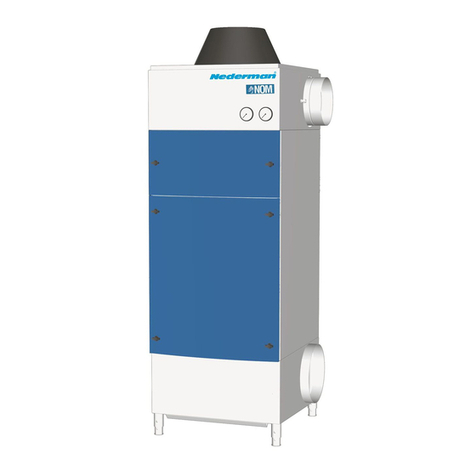
Nederman
Nederman NOM 18 instruction manual
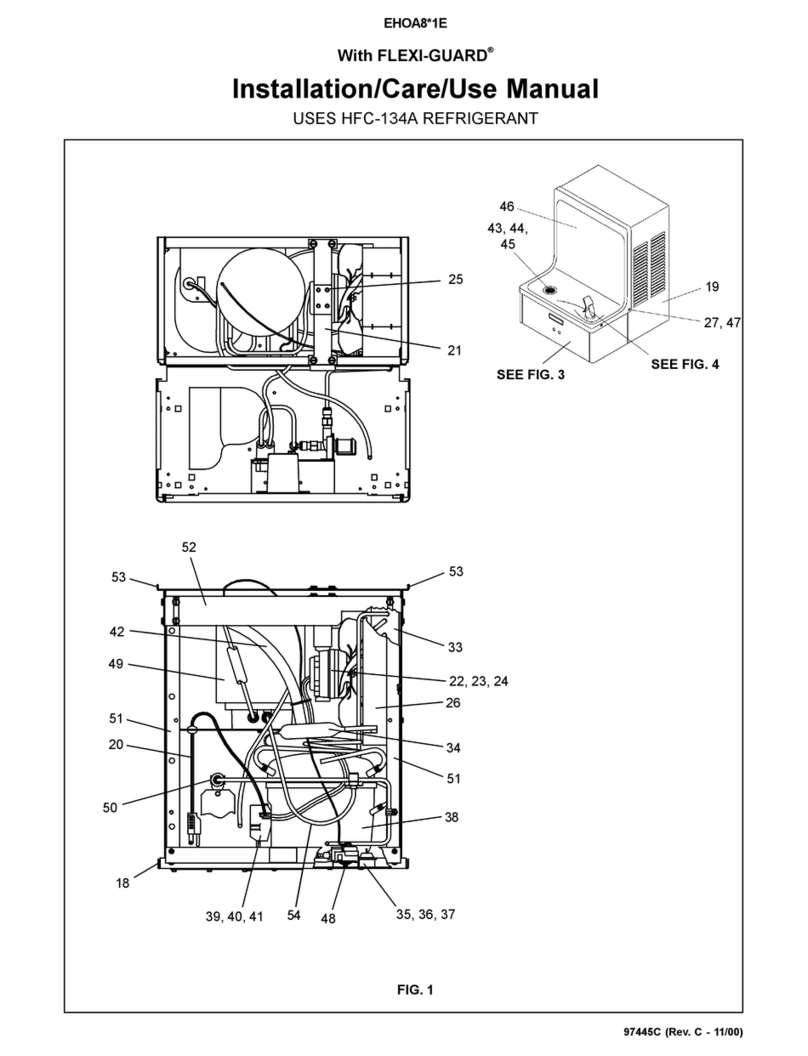
Drinking Fountain Doctor
Drinking Fountain Doctor EHOA8*1E Installation use and care manual
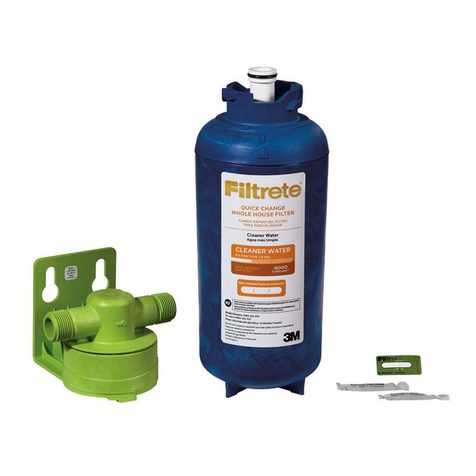
3M
3M Filtrete 4WH-QS-S01 Installation and operating instructions
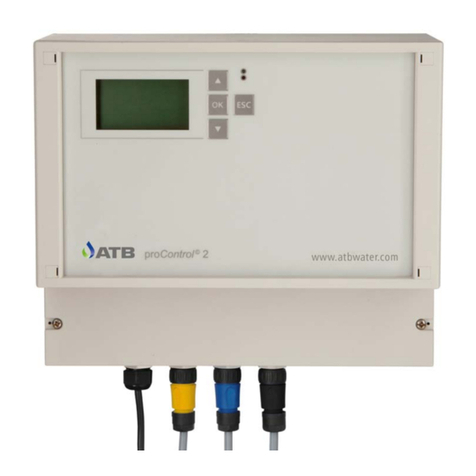
ATB
ATB AQUAMAX PRO G operating instructions
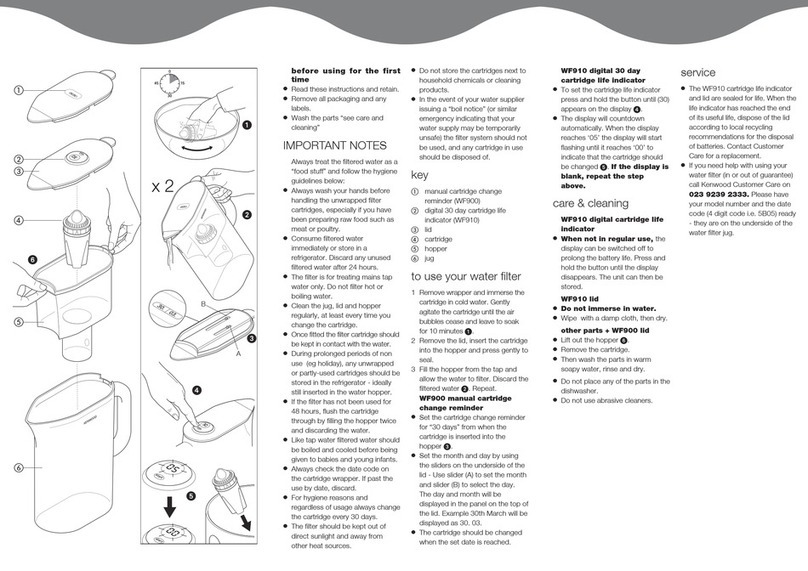
Kenwood
Kenwood WF900 quick start guide

Pure Blue H20
Pure Blue H20 PB-TLRO4H50T instruction manual

